Yo, what’s up, my homies, Shaker Mousa is in da house.
Well, actually Shaker Mousa is not an east coast rapper’s artistic nom de plume, but a dishonest pharmacology professor in Albany, NY, who combines food ingredients with nanotechnology and photoshop to cure various diseases.
His CV describes Shaker A. Mousa, Ph.D., M.B.A., FACC, FACB as a former principal research scientist at DuPont who after 17 years there moved to academia and is now “an endowed, tenured Professor and Executive Vice President and Chairman of the Pharmaceutical Research Institute (PRI)” and a former Vice Provost for Research at Albany College of Pharmacy and Health Sciences. I should mention that this impressive-sounding PRI consists solely of its president Mousa and his octogenarian business partner Paul J. Davis, plus some assistants. You will meet Davis, the man who used to run the medicine in Albany and at University at Buffalo, a lot.
We are also informed that the Egypt-born pharmacologist has an h-index of 81 and is “a Visiting Professor of Bioethics at Albany Medical College“.
That dude teaches students on the subject of biomedical research ethics, seriously. I think know why Mousa got that appointment. You need a real expert to talk of research fraud!
Let us start with curcumin, the most popular spice of green nanotechnology quacks and fraudsters (cf MD Anderson’s Bharat Aggarwal), and with a retraction.
Samah A Loutfy , Mostafa H Elberry , Khaled Yehia Farroh , Hossam Taha Mohamed , Aya A Mohamed , ElChaimaa B Mohamed , Ahmed Hassan Ibrahim Faraag , Shaker A Mousa Antiviral Activity of Chitosan Nanoparticles Encapsulating Curcumin Against Hepatitis C Virus Genotype 4a in Human Hepatoma Cell Lines International Journal of Nanomedicine (2020) doi: 10.2147/ijn.s241702
Figure 8A and 8B were identical, just stretched.

The paper was then corrected in February 2021 (“The authors apologize for this error and advise it does not affect the results of the paper“), but apparently that correction was problematic also.

On 5 July 2022, the paper was retracted:
“Concerns were raised regarding the alleged duplication of images in Figure 8. The authors responded to our queries and explained the western blot experiments were performed by a commercial laboratory; however, they were unable to provide all the original data. The data that was provided showed inconstancies between what was considered original western blot data and what was shown in Figure 8.”
Basically, the authors kind of admitted to have bought this “research study” from a papermill.
The retraction was only possible because the founding editor of International Journal of Nanomedicine, Thomas Webster, was sacked as Northeastern University professor and deposed as Editor-in-Chief after he pumped his own journal full of research fraud.
Thomas Webster to save the world with COVID-19 nanoparticles
The world is in the grip of COVID-19 pandemic. Thousands dead, infection rates explode, nations in lockdown. Perfect timing for troll scientists to offer their bullshit cures. Like Thomas Webster of Northeastern University.
Mousa has many papers on PubPeer (currently 27), among them is the following mysterious paper in the same ex-Webster journal.
Deena S Mousa, Ali H El-Far, Amna A Saddiq , Thangirala Sudha, Shaker A Mousa Nanoformulated Bioactive Compounds Derived from Different Natural Products Combat Pancreatic Cancer Cell Proliferation International Journal of Nanomedicine (2020) doi: 10.2147/ijn.s238256
Its first author is Mousa’s youngest daughter Deena Mousa, who works in consulting having recently graduated at Yale with BSc in ethics. A teenager at that time, Deena was celebrated in 2016 as “the prodigal high-school student who invented a mixture of chemical components that can stop severe bleeding faster than the medicines currently used in hospitals“, having worked as assistant a year “in a lab at the Albany College of Pharmacy – one that finally agreed on hosting her“. The article which however never mentioned that the hospitable lab belonged to her professorial daddy, with whom the young genius even holds patents on NanoNeutraceutical Compositions.
Now, what did the image integrity sleuth Cheshire (who comments on PubPeer as Actinopolyspora Biskrensis) find in the young prodigy’s important biomedical study with her genius daddy? Do nanoparticles flavoured with broccoli and raspberry extracts really cure cancer?

Molecules (2017)“
The image in the above the broccoli anti-cancer study was inappropriately recycled from an MDPI paper about garlic against thrombosis. The co-author of the latter study, Shaymaa Mousa, works at IBM, never had anything to do with biomedical research, and is another daughter of our hero, the oldest of his 5 children:
Eric Block, Benjamin Bechand, Sivaji Gundala, Abith Vattekkatte, Kai Wang , Shaymaa S Mousa, Kavitha Godugu, Murat Yalcin, Shaker A Mousa Fluorinated Analog NMR s of Organosulfur Compounds from Garlic (Allium sativum): Synthesis, Chemistry and Anti-Angiogenesis and Antithrombotic Studies Molecules (2017) doi: 10.3390/molecules22122081
There, Cheshire discovered:
“The two images published in the Figure 5s above was originally published in Figure 2A Endocrinology (2006), DOI: 10.1210/en.2005-1390 where it was described yet differently. However, in November of 2006 a correction replaced all of the images in that figure saying, “representative images from a study were shown, but the images were inadvertently selected by the authors from results of studies with a different thyroid hormone analog.
A second image from the original Endocrinology (2006) paper also appears in this Molecules (2017) paper (marked with magenta below).“

This was the Endocrinology paper, it has no edible ingredients:
Shaker A. Mousa , Laura O’Connor , Faith B. Davis , Paul J. Davis Proangiogenesis action of the thyroid hormone analog 3,5-diiodothyropropionic acid (DITPA) is initiated at the cell surface and is integrin mediated Endocrinology (2006) doi: 10.1210/en.2005-1390
Now, the co-author Faith Davis was the wife of Paul Davis, and internist-endocrinologist at Albany Medical Center, she died of Alzheimer’s aged 81 in 2017. She is co-author on a number of forged studies. Neither Paul Davis nor Shaker Mousa replied to my emails.
Cheshire also wondered:
“…if If that image existed in 2006, how is it that they then show up in a 2017 paper, and one again in 2020, all described differently. If I continue looking will I find it again in the early 2000s?“
He proved himself right.
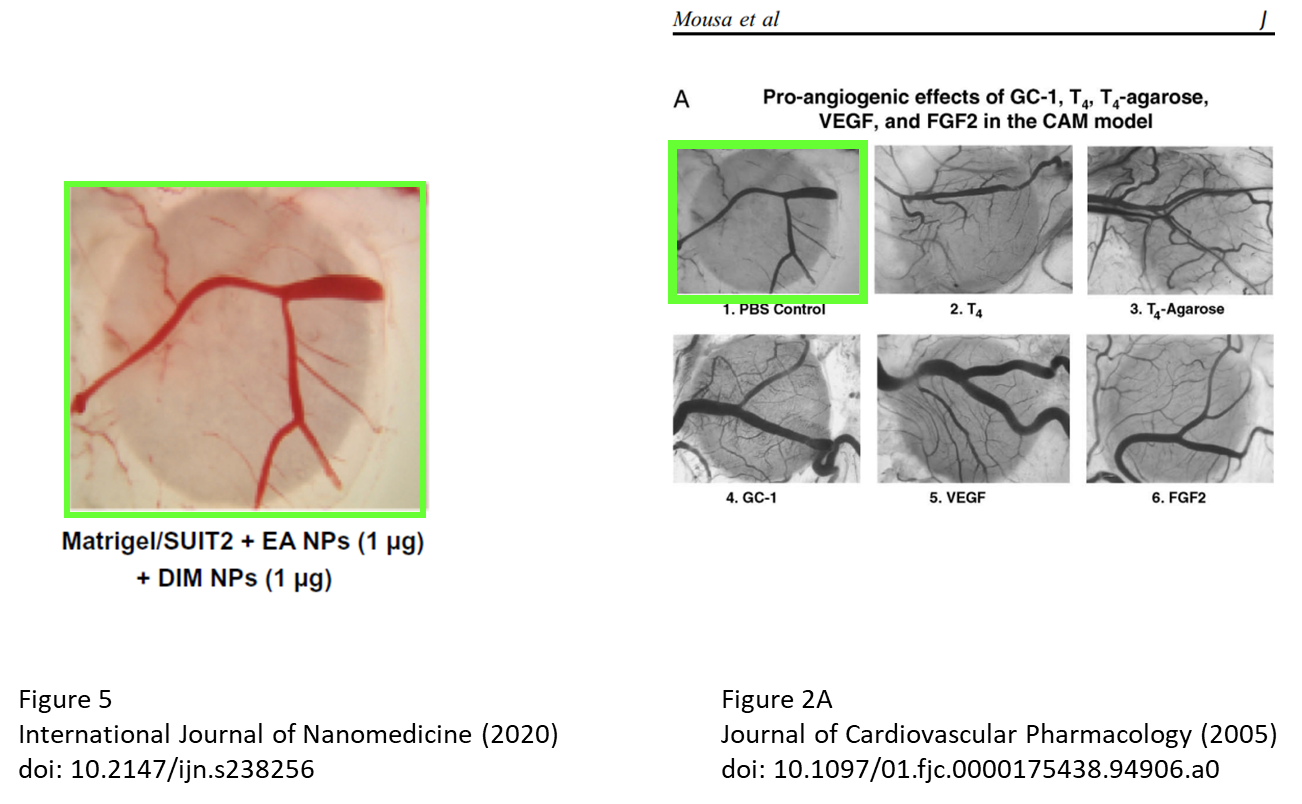
It was a paper from 2005, also about the thyroid hormone.
Shaker A Mousa, Laura J O’Connor , Joel J Bergh , Faith B Davis , Thomas S Scanlan , Paul J Davis The proangiogenic action of thyroid hormone analogue GC-1 is initiated at an integrin Journal of Cardiovascular Pharmacology (2005) doi: 10.1097/01.fjc.0000175438.94906.a0
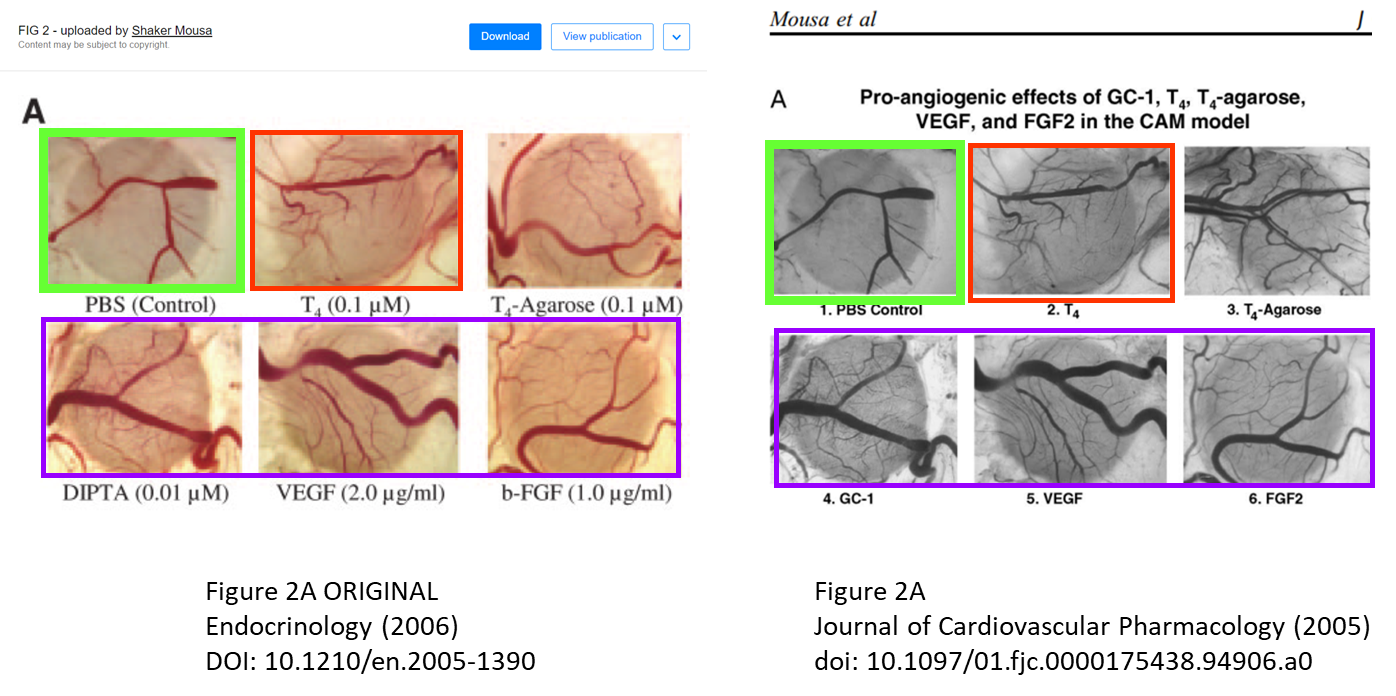
Additionally, yet another figure from Block et al Molecules 2017 proved to be second-hand and repurposed:

The microscopy image derived from a paper about resveratrol (once a magic drug against cancer, ageing, and everything):
Sarah S. Mousa , Shaymaa S. Mousa & Shaker A. Mousa Effect of Resveratrol on Angiogenesis and Platelet/Fibrin-Accelerated Tumor Growth in the Chick Chorioallantoic Membrane Model Nutrition & Cancer (2009) doi: 10.1207/s15327914nc5201_8
You see the authors are Shaker Mousa and his daughters: Shaymaa you met already, and Sarah Mousa is a consultant, journalist and founder of a solar energy startup. Not really a biomedical researcher either, but all Shaker’s kids are geniuses, due to quality genes they inherited from their dad.
But how did all these old pictures end up in new papers? Presumably, Shaker Mousa discovered the healing powers of food-based nanoparticles, but lacked the data to support his visionary discoveries. So his old stuff, for example about thyroid hormone, had to do.
Another thyroid hormone deficiency was elegantly solved with a correction:
Ozlem Ozen Karakus, Noureldien H. E. Darwish, Thangirala Sudha, Taher A. Salaheldin, Kazutoshi Fujioka, Peter C. Taylor Dickinson, Brian Weil, Shaker A. Mousa Development of Triiodothyronine Polymeric Nanoparticles for Targeted Delivery in the Cardioprotection against Ischemic Insult Biomedicines (2021) doi: 10.3390/biomedicines9111713

Mousa, who just happens to be the Editor-in-Chief of this MDPI journal, made two things clear:
- “Regarding to image 6A; we check the images, and we didn’t find any overlap between the images as well as throughout our image’s library.
- Also, regarding the 2nd comments (Note: the last author appears to be Editor-in-Chief of this journal); our Manuscript has been handled by independent editors excluding Dr. Mousa from the whole process.“
On 8 June 2022, the perfectly unbiased Editor-in-Chief issued a correction:
“…in Figure 6A there was an unintentional mistake of an overlap in Figures under different treatment conditions while taking photographs/labeling at a lower magnification. Experiment was repeated and photographs were taken under higher magnification for improved image quality. The scientific conclusion was unaffected and there is no change in the legend of the figure. The published figure is replaced with the new Figure 6A.”
I guess then it’s safe to inject thyroid hormone coated plastic nanoparticles into the hearts of cardiovascular patients.
Here another case of reused images, again on thyroid hormone and again from Mousa’s and Davis’ own PRI in Albany, NY:
Kavitha Godugu, Shaker A. Mousa, Gennadi V. Glinsky , Hung-Yun Lin , Paul J. Davis In Vivo Clearance of Apoptotic Debris From Tumor Xenografts Exposed to Chemically Modified Tetrac: Is There a Role for Thyroid Hormone Analogues in Efferocytosis? Frontiers in Endocrinology (2022) doi: 10.3389/fendo.2022.745327

Mousa replied on PubPeer in April 2022 that the first author and PRI employee Kavitha Godugu did the entire study and wrote the paper all by herself, the other authors merely contributed some editing. He also denied the images were duplicated:
“Here is the response from the lead author Dr. Godugu The image in both Figure 2 and Figure 3 are different…“
But the images were identical, as further analysis proved. Cheshire also noticed that this study was funded by a company called NanoPharmaceuticals which Mousa and Davis founded and operate, both with the title of “Founder and Executive Vice President”. The business model is to convert fake thyroid hormone research into real money for Mousa and Davis. An open-label phase 1 clinical trial (NCT05226494) with a thyroid hormone agonist on 28 glioblastoma patients has just been registered.
As for the criticised thyroid hormone agonist paper, Mousa announced to issue a correction, but only about the “author contributions”, and not the fake figure. A correction which he probably will send to himself as associate editor.
Also here, in a study where lead poisoning was miraculously cured with anti-coagulant heparin, Mousa blamed the first authors:
Shimaa M. Motawei, Thangirala Sudha, Murat Yalcin, Kavitha Godugu, Shaker A. Mousa Lead-induced endothelial cell dysfunction: protective effect of sulfated non-anticoagulant low molecular weight heparin Toxicology and Environmental Health Sciences (2021) doi: 10.1007/s13530-021-00089-3
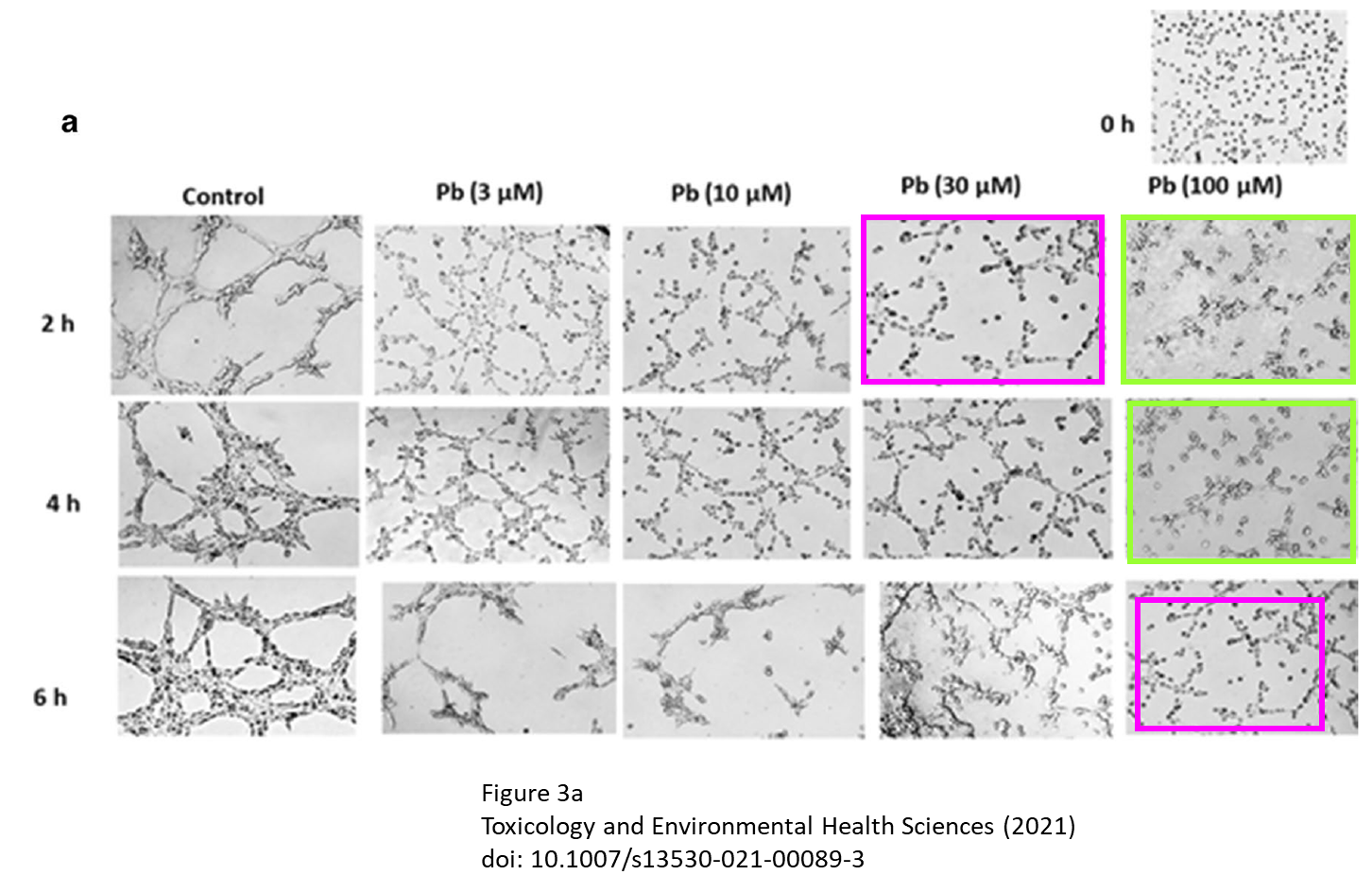
The PRI president agreed to replace the blue-marked duplicated images, but the green-marked ones are to remain, presumably they are of different contrast. This was his (non-negotiable?) offer:

This pattern of image recycling existed for years. Here, almost two decades old, Mousa was already at the Albany College of Pharmacy, working with a different husband-and-wife team:
Meghna U. Naik , Shaker A. Mousa, Charles A. Parkos , Ulhas P. Naik Signaling through JAM-1 and alphavbeta3 is required for the angiogenic action of bFGF: dissociation of the JAM-1 and alphavbeta3 complex Blood (2003) doi: 10.1182/blood-2003-04-1114

Would you rather have some food nanotech again? Let’s have more of the nanoformulated “Ellagic acid, which is found in nuts and berries“, which Mousa and his prodigy youngest daughter proved as a cancer cure above:
Thikryat Neamatallah , Nagla El-Shitany , Aymn Abbas , Basma G. Eid , Steve Harakeh, Soad Ali , Shaker Mousa Nano Ellagic Acid Counteracts Cisplatin-Induced Upregulation in OAT1 and OAT3: A Possible Nephroprotection Mechanism Molecules (2020) doi: 10.3390/molecules25133031

The following cases might provide a clue why the microscopy images needed to be reused. Mousa’s lab doesn’t have enough of them apparently, and neither do his partners in Egypt. What to do? It is quite possible that image data figures were pulled from who knows which and whose published papers, their original markings and labels digitally removed, the end result are the small pattern duplications and other irregularities. That’s by the way what papermills do.
So here a study on amazing health effects of the carotenoid (yes, the orange carrot dye) lycopene:
Mohamed M Abdel-Daim, Rasha Eltaysh, Azza Hassan, Shaker A Mousa Lycopene Attenuates Tulathromycin and Diclofenac Sodium-Induced Cardiotoxicity in Mice International Journal of Molecular Sciences (2018) doi: 10.3390/ijms19020344

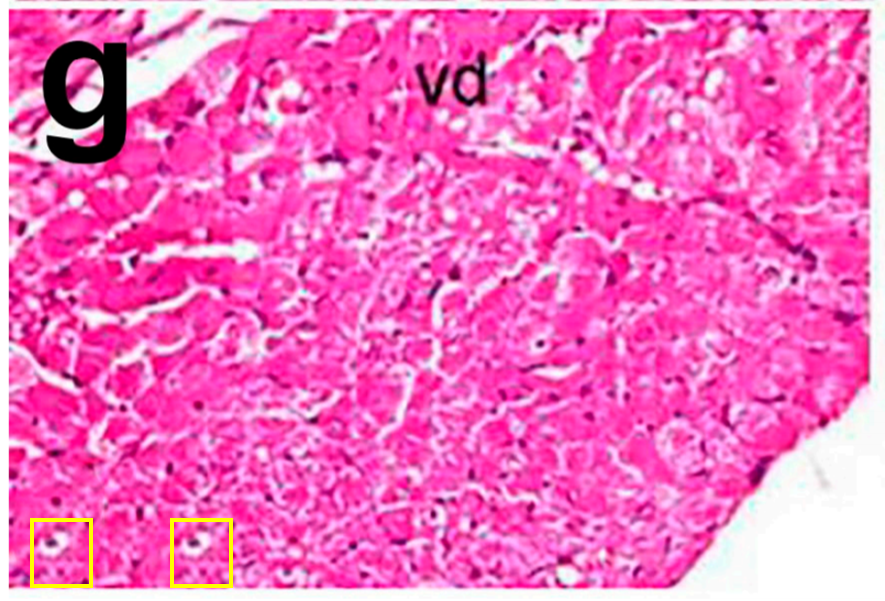

A similar problem was spotted in Chamcheu et al 2018, where the authors confidently assured that green tea polyphenol-soaked nanoparticles can cure psoriasis (yes!), but found themselves unable to post a high-resolution original image when criticism arose.
The first author Jean-Christopher Chamcheu explained on PubPeer:
“the blue staining is just a counterstaining and does not alter the outcome of the study, in which herein the targets are green and red staining.“
Another suspicious paper, about the rejuvenating power of curcumin, in that same MDPI journal, where one wonders who really wrote it and where the figures really came from.
Ali H. El-Far , Yaser H. A. Elewa , Elsayeda-Zeinab A. Abdelfattah , Abdel-Wahab A. Alsenosy, Mustafa S. Atta, Khalid M. Abou-Zeid , Soad K. Al Jaouni , Shaker A. Mousa, Ahmed E. Noreldin Thymoquinone and Curcumin Defeat Aging-Associated Oxidative Alterations Induced by D-Galactose in Rats’ Brain and Heart International Journal of Molecular Sciences (2021) doi: 10.3390/ijms22136839
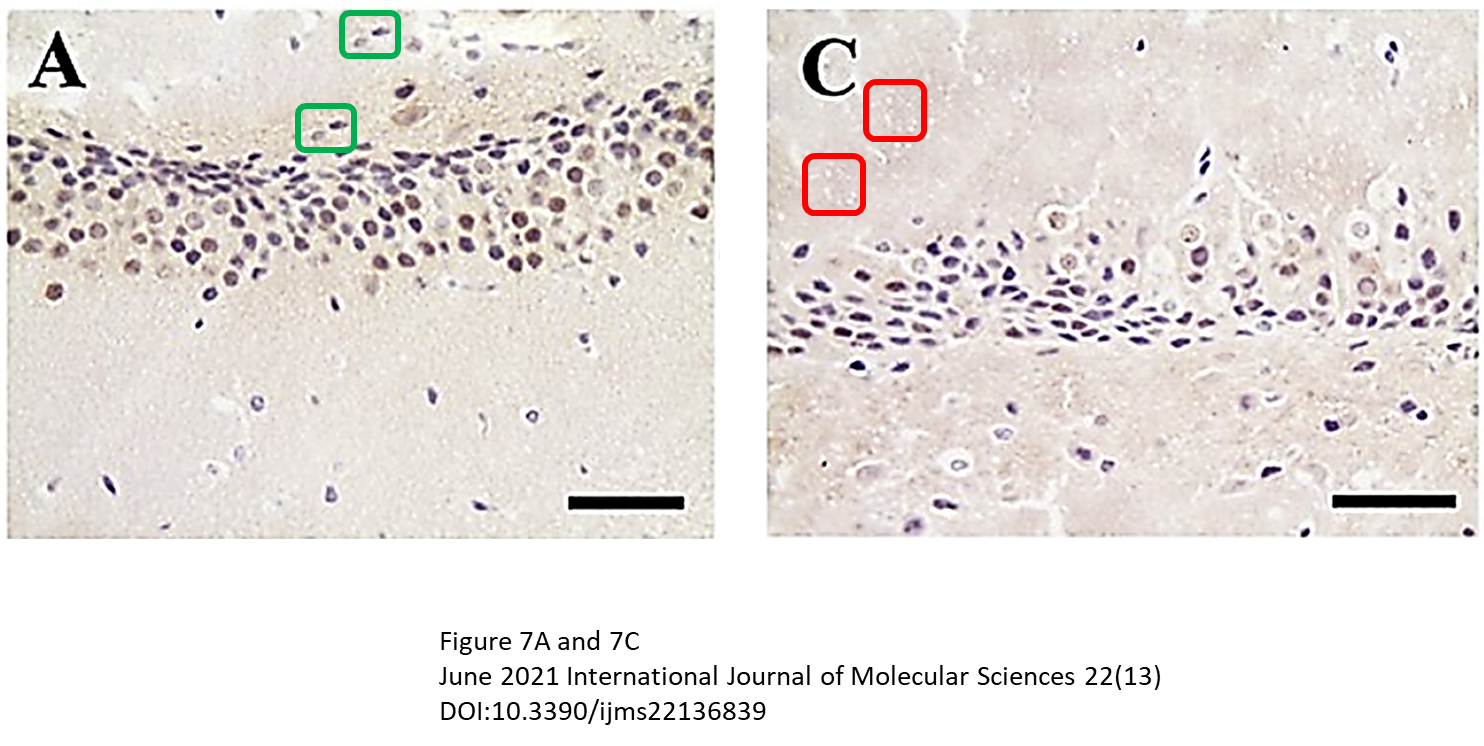


Mousa’s coauthor Ali El-Far dismissed all criticism with a long list of papers about curcumin, and a statement:
“As I found in my field of interest, using natural bioactive compounds is significant for the protection or treatment of numerous diseases, especially when it is used in nanoformulations.“
Maybe Mousa and his partners have access to a local papermill? There are Chinese papermills, Indian, Iranian, russian, so why not an Egyptian one?
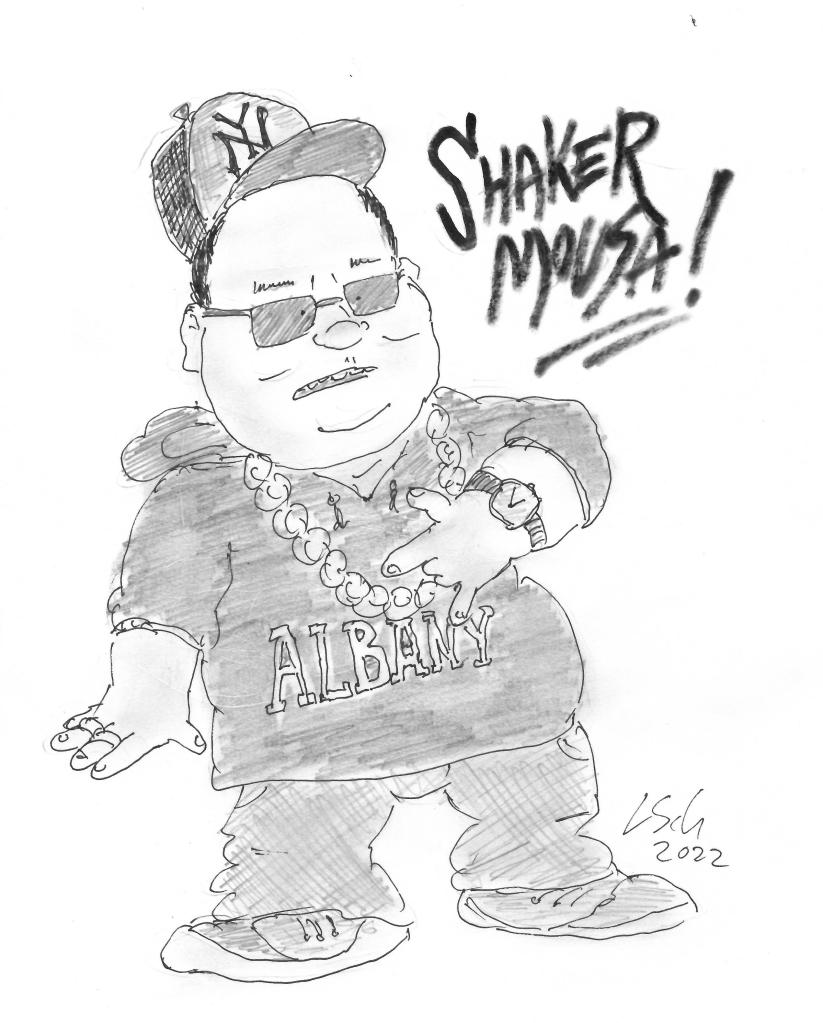
El-Far, the proud carrier of a big black bushy beard and a title of professor at the Damanhour University in Egypt, also teamed up with Mousa to suggest yeast extract to upscale rabbit meat production because “Rabbit meats are also highly digestible, delicious, and low-calorie foods that nutritionists often recommend“.
Mahmoud M. Abo Ghanima , Ayman H. Abd El-Aziz , Ahmed E. Noreldin , Mustafa S. Atta , Shaker A. Mousa, Ali H. El-Far β-glucan administration improves growth performance and gut health in New Zealand White and APRI rabbits with different breed responses PLoS ONE (2020) doi: 10.1371/journal.pone.0234076

El-Far commented on PubPeer:
“It is an image of one microscopic field. The two parts you referred to arrows are different. Also, its significant lesion for us to repeat it.“
Yep, it would be a “significant lesion” for these Egyptian “scientists” to forge or even to buy some replacement fake figures all over again. But then again, El-Far even knows where to get fake flow cytometry and tumour array pictures to claim that a substance from lettuce can cure cancer, but only when smeared onto nanoparticles:
Ali H. El-Far , Kavitha Godugu , Taher A. Salaheldin , Noureldien H. E. Darwish , Amna A. Saddiq , Shaker A. Mousa Nanonutraceuticals: Anti-Cancer Activity and Improved Safety of Chemotherapy by Costunolide and Its Nanoformulation against Colon and Breast Cancer Biomedicines (2021) doi: 10.3390/biomedicines9080990



Also here, El-Far chose to bullshit and to denounce the criticisms as “unscientific”, knowing his paper to be perfectly safe. After all, this is the MDPI journal where Mousa is Editor-in-Chief. Apparently the paper already received a stealth correction to replace the cloned tumours.
If you want to look at more forged immunohistochemistry figures by Mousa and his Egyptian mates, here:



Speaking of papermills: Mousa has no problems to publish in journals which specialise to catering to papermills. Like here, another study about carrot dye nanoparticles, but this time for bone health, published in the notorious European review for medical and pharmacological sciences by Verduci Editore.
M.S.M. Ardawi, M.H. Badawoud , S.M. Hassan , A.M.S. Ardawi , A.A. Rouzi , M.H. Qari , S.A. Mousa Lycopene nanoparticles promotes osteoblastogenesis and inhibits adipogenesis of rat bone marrow mesenchymal stem cells European review for medical and pharmacological sciences (2021) doi: 10.26355/eurrev_202111_27238

The authors announced a correction.
Il Piccolo Mulino Verduci Frodatore
“I choose to think of the paper-mills as something like a mediaeval monastic scriptorium, with one table of tonsured monks working on the text, while the limners at another table illuminate the Figures.” – Smut Clyde
And this groundbreaking nanotheranostics study was published by Mousa and his Egyptian friends in a certified predatory journal by a certified predatory publisher (cf Bramstedt 2020):
AMOURA M. ABOU-EL-NAGA, SHAKER A. MOUSA, FAYEZ ALTHOBAITI , EMAN FAYAD , ENGY S. FAHIM Ameliorative effects of melatonin and zinc oxide nanoparticles treatment against adverse effects of busulfan induced infertility in male albino mice BIOCELL (2022) doi: 10.32604/biocell.2022.017739


Mousa then blamed on PubPeer “the lead authors who conducted the experiments (last author and first author)” and insisted that “In figure 4: these regions represent the lipid droplets“. Those were however immunohistochemistry images of mouse tissues, but I presume the authors haven’t read what they wrote themselves bought off a mill.
But you probably want to see some fake western blots, don’t you? There is a lot in Mousa’s and Davis’ old thyroid hormone papers, and flagged years ago by Clare Francis.
Shaker A. Mousa, Murat Yalcin , Dhruba J. Bharali , Ran Meng , Heng-Yuan Tang , Hung-Yun Lin , Faith B. Davis , Paul J. Davis Tetraiodothyroacetic acid and its nanoformulation inhibit thyroid hormone stimulation of non-small cell lung cancer cells in vitro and its growth in xenografts Lung Cancer (2012) doi: 10.1016/j.lungcan.2011.10.003

In the next one, it was particularly mean of Paul Davis to have put his wife as first author on a massive forgery. She can’t defend herself now. And yet another co-author, Ahmed Mousa, is yet another child of our hero. This kid also works in consulting and never had anything to do with biomedicine, except co-authoring daddy’ papers of course.
Faith B. Davis, Heng-Yuan Tang , Ai Shih , Travis Keating , Lawrence Lansing , Aleck Hercbergs , Robert A. Fenstermaker , Ahmed Mousa , Shaker A. Mousa, Paul J. Davis, Hung-Yun Lin Acting via a cell surface receptor, thyroid hormone is a growth factor for glioma cells Cancer Research (2006) doi: 10.1158/0008-5472.can-05-4365


These and other fake gels with cloned bands have been flagged on PubPeer in 2015 already, but so far all these society journals found themselves unable to do anything. Maybe they wait for the Ordway Research Institute in Albany, which Davis used to run on behalf of a billionaire donor, to finally announce the results of its investigation? The institute went bankrupt and dissolved itself in 2011.
Thus, more Ordway Institute fraud, again on thyroid hormone:
Hung-Yun Lin , Mingzeng Sun , Heng-Yuan Tang , Cassie Lin , Mary K. Luidens , Shaker A. Mousa , Sandra Incerpi , George L. Drusano , Faith B. Davis , Paul J. Davis l-Thyroxine vs. 3,5,3′-triiodo-l-thyronine and cell proliferation: activation of mitogen-activated protein kinase and phosphatidylinositol 3-kinase AJP Cell Physiology (2009) doi: 10.1152/ajpcell.00305.2008






Hung-Yun Lin, whose name you keep encountering, sure made a fine career with fake science, thanks to Davis’ mentorship. First, assistant professor at Albany Medical College, then senior scientist at Ordway Research Institute in Albany, and after that went bankrupt, professor at the Taipei Medical University in Taiwan. Lin is also Board member at Davis’ other company, Signal Transduction, Inc, which was founded right after the Ordway institute went bust. This company doesn’t have a web presence even, but is still listed as active. Maybe it changed its mailbox address and transformed into NanoPharmaceuticals?
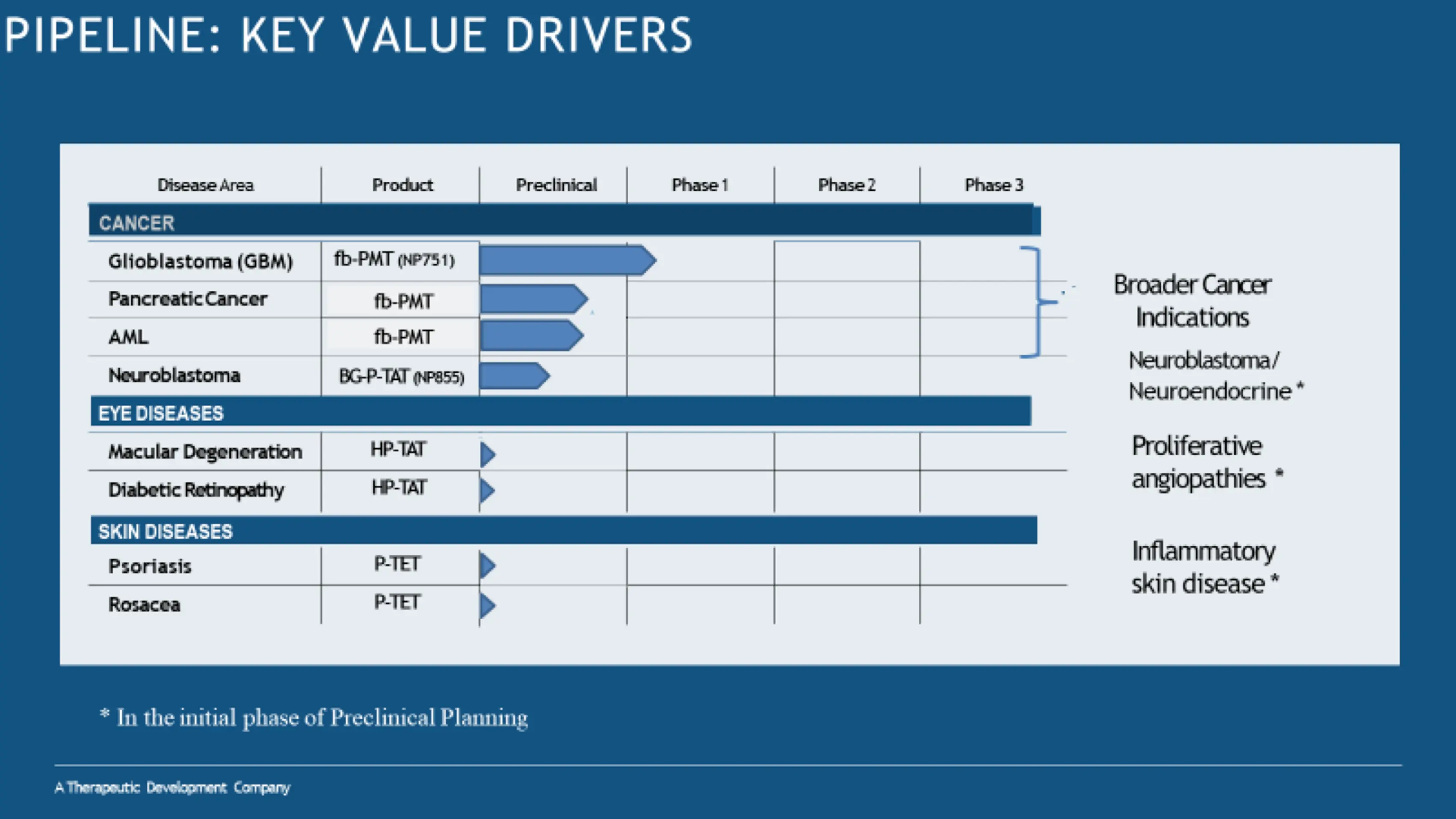
Have a look at more fake thyroid hormone research by Lin, Mousa, and the Davises, in yet another society journal:
Joel J. Bergh , Hung-Yun Lin , Lawrence Lansing , Seema N. Mohamed , Faith B. Davis , Shaker Mousa, Paul J. Davis Integrin alphaVbeta3 contains a cell surface receptor site for thyroid hormone that is linked to activation of mitogen-activated protein kinase and induction of angiogenesis Endocrinology (2005) doi: 10.1210/en.2005-0102


But maybe PLOS One could take care of this thyroid-hormone-against-cancer quackery maybe? Also flagged in 2015, by Clare Francis:
Ran Meng , Heng-Yuan Tang , Jennifer Westfall , David London , James H. Cao , Shaker A. Mousa , Mary Luidens , Aleck Hercbergs , Faith B. Davis , Paul J. Davis , Hung-Yun Lin Crosstalk between integrin αvβ3 and estrogen receptor-α is involved in thyroid hormone-induced proliferation in human lung carcinoma cells PLoS ONE (2011) doi: 10.1371/journal.pone.0027547


Another one, here Mousa, the Davises, Lin and another regular, Murat Yalcin (now professor in Turkey), decided to dab thyroid hormone onto some nanoparticles, and wham, cancer was cured even faster:
Murat Yalcin , Hung-Yun Lin , Thangirala Sudha , Dhruba J. Bharali , Ran Meng , Heng-Yuan Tang , Faith B. Davis , Steven C. Stain, Paul J. Davis , Shaker A. Mousa Response of human pancreatic cancer cell xenografts to tetraiodothyroacetic acid nanoparticles Hormones and Cancer (2013) doi: 10.1007/s12672-013-0137-y
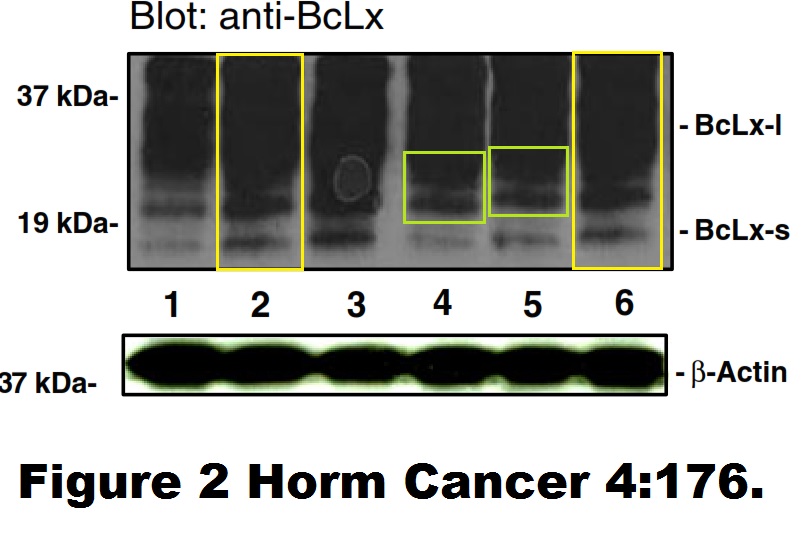
Let’s end with another retraction, again it’s about anti-cancer nanoparticles.
Amoura M Abou-El-Naga , Ghada Mutawa , Ibrahim M. El-Sherbiny , Shaker A. Mousa Activation of polymeric nanoparticle intracellular targeting overcomes chemodrug resistance in human primary patient breast cancer cells International Journal of Nanomedicine (2018) doi: 10.2147/ijn.s182184

The retraction notice from 3 June 2022 stated:
“Concerns were raised regarding the alleged manipulation of gel electrophoresis images in Figure 6A which appeared to show the bands had been spliced together.
The authors responded to our queries and confirmed the original gel images had been spliced for clarity. However, the authors were unable to provide the original data for the gel electrophoresis experiments and could not verify the original results or findings.”
I see a very grim future for Mousa’s and Davis’ business Nanopharmaceuticals if this is the kind of science they aim to market. Should have sold it before the fraud came out, learn from David Sinclair!
Never-ageing Anti-aging to cure COVID-19
Scientists David Sinclair and Michael Lisanti have an ingenious solution to COVID-19: anti-aging drugs. If a disease kills old people, stop being old!
I am also worried which kind of ethics and values Shaker Mousa taught his kids, but then again, maybe this is why they all made such impressive careers in business.
I thank all my donors for supporting my journalism. You can be one of them!
Make a one-time donation:
I thank all my donors for supporting my journalism. You can be one of them!
Make a monthly donation:
Choose an amount
Or enter a custom amount
Your contribution is appreciated.
Your contribution is appreciated.
DonateDonate monthly




“ Maybe Mousa and his partners have access to a local papermill? There are Chinese papermills, Indian, Iranian, russian, so why not an Egyptian one?”
https://pubpeer.com/publications/AF4B7D3A8F2D1FDAFC3700A6E8C2A8
Material science, though.
LikeLiked by 1 person
The quintessential For Better Science article! Its got everything- stem cells, nanomedicine, crooked university administrators/leaders on the grift, shocking figure manipulation, monetization of fake research, scam conferences…Its the total package.
My only suggestion is that “Shakka” Musa has more of a Jamaican dancehall vibe so I might suggest listening to his in the background while reading the article.
LikeLiked by 1 person
Also, its a minor transgression in the scale of things but Mousa identifies himself (on his web site) as an elected Fellow of the American College of Cardiology but eligibility for this is restricted to physicians with subspecialty training in cardiology and he is neither of these So he probably made that up as well
https://www.acc.org/membership/join-us/facc
Election to Fellowship is based on training and specialty board certification in cardiology. Members are expected to conform to high moral standards.
LikeLike
I’m quite disappointed that no one has commented on his paper on Camel urine.
August 2011Journal of alternative and complementary medicine (New York, N.Y.) 17(9):803-8
DOI:10.1089/acm.2010.0473
LikeLike
Abdulqader Alhaidar, Abdel Galil M. Abdel Gader, and Shaker A. Mousa The Antiplatelet Activity of Camel Urine Journal of Alternative and Complementary Medicine. (2011) doi: 10.1089/acm.2010.0473
“Urine was collected from healthy virgin, pregnant, and lactating camels aged 2–10 years.”
LikeLike
I thought Shaker Mousa and Paul J Davis would stop. I was wrong.
LikeLike
Kavitha Godugu, Mehdi Rajabi, Shaker A. Mousa Anti-Cancer Activities of Thyrointegrin αvβ3 Antagonist Mono- and Bis-Triazole Tetraiodothyroacetic Acid Conjugated via Polyethylene Glycols in Glioblastoma

Cancers (2021) doi: 10.3390/cancers13112780
Actinopolyspora biskrensis: “Figure 5A, Cancers (2021), doi: 10.3390/cancers13112780, https://pubpeer.com/publications/69D341D721A4C7B04B72F72ECB8B56
Figure 6b, Journal of Cellular Biochemistry (2006), doi: 10.1002/jcb.20741, https://pubpeer.com/publications/B2CD4247C7FD618A2B0A79CB266F5B“
LikeLike
More, by Cheshire:


Weikun Li , Murat Yalcin , Dhruba J. Bharali , Qishan Lin , Kavitha Godugu , Kazutoshi Fujioka , Kelly A. Keating , Shaker A. Mousa Pharmacokinetics, Biodistribution, and Anti-Angiogenesis Efficacy of Diamino Propane Tetraiodothyroacetic Acid-conjugated Biodegradable Polymeric Nanoparticle Scientific Reports (2019) doi: 10.1038/s41598-019-44979-6
“Figure 10 seems to include at least one image that was previously published in a corrected Figure 2A of Endocrinology (2006), DOI: 10.1210/en.2005-1390.”
“The images in Figure 10 also seem to appear in a 2009 paper where some are described differently. Nanotechnology (2009), DOI:10.1088/0957-4484/20/45/455104.”
LikeLike
More by Cheshire:

Mehdi Rajabi , Kavitha Godugu , Thangirala Sudha , Dhruba J. Bharali , Shaker A. Mousa Triazole Modified Tetraiodothyroacetic Acid Conjugated to Polyethylene Glycol: High Affinity Thyrointegrin αvβ3 Antagonist with Potent Anticancer Activities in Glioblastoma Multiforme Bioconjugate Chemistry (2019) doi: 10.1021/acs.bioconjchem.9b00742
“Figure 5c looks like a jigsaw puzzle. Green arrows indicate likely splices. Magenta boxes indicate what appears to be a duplicated tumor, although the rightmost image has been resized (for what purpose?). Perhaps the reviewers should have taken more than 1 week in their consideration.
I note that NanoPharmaceuticals LLC includes this paper on their Publications page.
ACKNOWLEDGMENTS. Funding was received from both NanoPharmaceuticals LLC and from the Pharmaceutical Research Institute at Albany College of Pharmacy and Health Sciences.”
LikeLike
LikeLike
““The bacteria are actually smarter than the chemists in this case,” says Shaker Mousa, a professor at the Albany College of Pharmacy and Health Sciences in New York and a coauthor of the new study, which is published in this week’s Science.”
https://www.technologyreview.com/2011/10/28/189986/a-more-modern-blood-thinner/
But he did publish in Science, which by definition proves Shaker Mousa is a genius and his research groundbreaking and life-saving and 100% reliable. Gosh, Holden Thorp will hate me even more now…
https://www.science.org/doi/pdf/10.1126/science.1207478
LikeLike
Are there more? Yes there are.
LikeLiked by 1 person
According to an anonymous commenter on Reddit, Dr. Mousa has retired and the Pharmaceutical Research Institute (PRI) is being shut down. The website for the institute appears to be offline (https://pri-albany.org/about/)
Source: https://www.reddit.com/r/ACPHS/comments/x7mx1i/pharmaceutical_research_institute/
LikeLike
The same commenter continued today, “Per the announcement that was sent to the entire campus, he is still serving as a part-time professor in pharmaceutical sciences.”
LikeLike
Here’s the link, in case they add more info
LikeLike
LikeLike
https://www.mdpi.com/journal/biomedicines/awards/2099 MDPI still has Dr. Mousa as Editor in Charge of Biomedicines, and he’ll be giving out Young Investigator Awards in October 2023.
LikeLiked by 1 person
Steve Harakeh, a minor character encounted here, is now also spotted in association with Abhijit Dey, creating a direct link to the fraud cluster of Javad Sharifi-Rad.
https://pubpeer.com/publications/F6780B046AE930165A02F1CC89D533
https://pubpeer.com/search?q=authors%3A%22abhijit+dey%22
LikeLike
A tweet for some context:
LikeLike
And another one, featuring Dey in a different environment of fraudsters, including an “odd Pole” Jarosław Proćków.
LikeLike
Here we go again
LikeLike
Damn dawg. Shaker Mousa is on fire.
First, a retraction of a paper that I didn’t flag. https://ar.iiarjournals.org/content/43/10/4780.long
The paper, “is retracted due to image manipulation as proven following an investigation by the Albany College of Pharmacy and Health Sciences.” Seems like the school actually did a real investigation and didn’t just rely upon my annoying PubPeer posts (kudos to the school).
Then, I received this email from MDPI, where he is Editor in Chief of their journal Biomedicines after asking if they knew why he was disappeared from the ACPHS website:
“Dear Reader,
Thank you for your email.
In 2020, our Editor in Chief, Prof. Dr. Shaker Mousa, has had some
serious health issues. Due to these issues, he has decided to close the
Pharmaceutical Research Institute (PRI) in 2022 to minimize the stress
levels. He has continued his remaining work on a part time basis until
he finished his last course in 2022 and then fully retired in early
2023. The new affiliation of our Editor in Chief has been displayed on
our website as well. Our journal does not intend, by any means, to
showcase discrepancies. We hope that this answers your query.
We wish you all the best.
—
Kind regards,
Ms. Ioana Vintila
Journal Relations Specialist
MDPI Open Access Publishing Romania SRL
77th Boulevard 21 Decembrie 1989
The Office, Building E, Floor 3
400604 Cluj-Napoca, Cluj
Romania
Tel. +40 364 150 134
http://www.mdpi.com”
They have updated his profile on their site to say, “Retired.”
LikeLike
Another retraction. I think this is #9. This is the second to mention the institutional investigation. h/t Smut Clyde.
https://pubpeer.com/publications/71A9E06EF71A912E8AC4D0324774A9
LikeLike
Another retraction mentioning the investigation.
https://pubpeer.com/publications/EDC5782C2E220C4508B1AAB9CB2C6E#2
LikeLike
15 January 2024 retraction for Shaker A Mousa.
https://academic.oup.com/carcin/advance-article/doi/10.1093/carcin/bgad095/7515211?login=false
This is a retraction of: Shaker A. Mousa, Laura O’Connor, Toby G. Rossman, Eric Block, Pro-angiogenesis action of arsenic and its reversal by selenium-derived compounds, Carcinogenesis, Volume 28, Issue 5, May 2007, Pages 962–967, https://doi.org/10.1093/carcin/bgl229
The above referenced article has been retracted by the editor and publisher following an investigation into Figure 1 conducted by the Albany College of Pharmacy and Health Sciences. The journal was notified in August 2023 that the institution had determined that the PBS (control), sodium arsenite, and VEGF images in Figure 1A were “associated with manipulation, re-use and relabeling” across multiple articles published between 2005 and 2020. The article is being retracted over the objections of the corresponding author, who co-authored each publication identified.
LikeLike